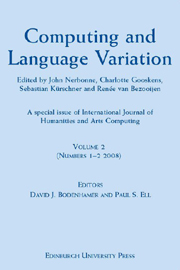Book contents
- Frontmatter
- Contents
- From the Editors
- Notes on Contributors
- 1 Introduction: Language Variation Studies and Computational Humanities
- 2 Panel Discussion on Computing and the Humanities
- 3 Making Sense of Strange Sounds: (Mutual) Intelligibility of Related Language Varieties. A Review
- 4 Phonetic and Lexical Predictors of Intelligibility
- 5 Linguistic Determinants of the Intelligibility of Swedish Words among Danes
- 6 Mutual Intelligibility of Standard and Regional Dutch Language Varieties
- 7 The Dutch-German Border: Relating Linguistic, Geographic and Social Distances
- 8 The Space of Tuscan Dialectal Variation: A Correlation Study
- 9 Recognising Groups among Dialects
- 10 Comparison of Component Models in Analysing the Distribution of Dialectal Features
- 11 Factor Analysis of Vowel Pronunciation in Swedish Dialects
- 12 Representing Tone in Levenshtein Distance
- 13 The Role of Concept Characteristics in Lexical Dialectometry
- 14 What Role does Dialect Knowledge Play in the Perception of Linguistic Distances?
- 15 Quantifying Dialect Similarity by Comparison of the Lexical Distribution of Phonemes
- 16 Corpus-based Dialectometry: Aggregate Morphosyntactic Variability in British English Dialects
11 - Factor Analysis of Vowel Pronunciation in Swedish Dialects
Published online by Cambridge University Press: 12 September 2012
- Frontmatter
- Contents
- From the Editors
- Notes on Contributors
- 1 Introduction: Language Variation Studies and Computational Humanities
- 2 Panel Discussion on Computing and the Humanities
- 3 Making Sense of Strange Sounds: (Mutual) Intelligibility of Related Language Varieties. A Review
- 4 Phonetic and Lexical Predictors of Intelligibility
- 5 Linguistic Determinants of the Intelligibility of Swedish Words among Danes
- 6 Mutual Intelligibility of Standard and Regional Dutch Language Varieties
- 7 The Dutch-German Border: Relating Linguistic, Geographic and Social Distances
- 8 The Space of Tuscan Dialectal Variation: A Correlation Study
- 9 Recognising Groups among Dialects
- 10 Comparison of Component Models in Analysing the Distribution of Dialectal Features
- 11 Factor Analysis of Vowel Pronunciation in Swedish Dialects
- 12 Representing Tone in Levenshtein Distance
- 13 The Role of Concept Characteristics in Lexical Dialectometry
- 14 What Role does Dialect Knowledge Play in the Perception of Linguistic Distances?
- 15 Quantifying Dialect Similarity by Comparison of the Lexical Distribution of Phonemes
- 16 Corpus-based Dialectometry: Aggregate Morphosyntactic Variability in British English Dialects
Summary
Abstract In this study 91 local Swedish dialects were analysed based on vowel pronunciation. Acoustic measurements of vowel quality were made for 18 vowels of 1,014 speakers by means of principal component analysis of vowel spectra. Two principal components were extracted explaining more than ¾ of the total variance in the vowel spectra. Plotting vowels in the PC1-PC2 plane showed a solution with strong resemblance to vowels in a formant plane. Per location averages of all speakers were calculated and factor analysis was run with the 91 locations as data cases and the two acoustic component of the 18 words as variables. Nine factors were extracted corresponding to distinct geographic distribution patterns. The factor scores of the analysis revealed co-occurrence of a number of linguistic features.
INTRODUCTION
The traditional method of identifying dialect areas has been the so-called isogloss method, where researchers choose some linguistic features that they find representative for the dialect areas and draw lines on maps based on different realisations of these features. One problem with the isogloss method is that isoglosses rarely coincide, and a second is that the choice of linguistic features is subjective and depends on what the researcher chooses to emphasise. Dialectometric research has been trying to avoid these problems by aggregating over large data sets and using more objective data-driven methods when determining dialect areas (Séguy, 1973; Goebl, 1982; Heeringa, 2004; Nerbonne, 2009).
- Type
- Chapter
- Information
- Computing and Language VariationInternational Journal of Humanities and Arts Computing Volume 2, pp. 189 - 204Publisher: Edinburgh University PressPrint publication year: 2009



